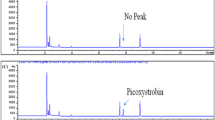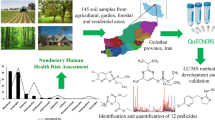Abstract
Plastic debris as new pollutants attracts much attention in the recent years. The plastic mulching films is one of the most important plastic debirs source in the environment. The aim of this work was to investigate the current status of pesticide residues on the plastic mulching films. Based on the QuEChERS method, multi-residue methods for detection of pesticide residues with gas chromatography tandem mass spectrum (GC-MS) and high performance liquid chromatography tandem mass spectrum (HPLC-MS) were developed for the analysis of the pesticides residues in plastic film and soil samples from Tianjin, Hebei and Shandong. The total concentrations of pesticide residues were in the range of 86.4–22213.2 ng/g in plastic film debris, which was about 20 times higher than that in soil (9.3–535.3 ng/g). Residual level of pesticides varied greatly in different samples. The historical usage and recent application of pesticides were the main sources for pesticide residues on plastic films and soil. In short, plastic mulching films could act as a sink for pesticides in farmland and the ubiquitous pesticide residues on plastic films should draw more attention.

Similar content being viewed by others
References
Anastassiades M, Lehotay S J, Stajnbaher D, Schenck F J (2003). Fast and easy multiresidue method employing acetonitrile extraction/partitioning and “dispersive solid-phase extraction” for the determination of pesticide residues in produce. Journal of AOAC International, 86(2): 412–431
Benedetti M, Cafiero L, Angelis D D, Dell’Era A, Pasquali M, Stendardo S, Tuffi R, Ciprioti S V (2017). Pyrolysis of WEEE plastics using catalysts produced from fly ash of coal gasification. Frontiers of Environmental Science & Engineering, 11(5): 11
Bonmatin J M, Giorio C, Girolami V, Goulson D, Kreutzweiser D P, Krupke C, Liess M, Long E, Marzaro M, Mitchell E A, Noome D A, Simon-Delso N, Tapparo A (2015). Environmental fate and exposure; neonicotinoids and fipronil. Environmental Science and Pollution Research International, 22(1): 35–67
Cooper J, Dobson H (2007). The benefits of pesticides to mankind and the environment. Crop Protection, 26(9): 1337–1348
Dai J, Dong H (2014). Intensive cotton farming technologies in China: Achievements, challenges and countermeasures. Field Crops Research, 155: 99–110
Engler R E (2012). The complex interaction between marine debris and toxic chemicals in the ocean. Environmental Science & Technology, 46(22): 12302–12315
Harner T, Bidleman T F, Jantunen L M, Mackay D (2001). Soil-air exchange model of persistent pesticides in the United States cotton belt. Environmental Toxicology and Chemistry, 20(7): 1612–1621
Huckins J N, Manuweera G K, Petty J D, Mackay D, Lebo J A (1993). Lipid-containing semipermeable membrane devices for monitoring organic contaminants in water. Environmental Science & Technology, 27(12): 2489–2496
Jambeck J R, Geyer R, Wilcox C, Siegler T R, Perryman M, Andrady A, Narayan R, Law K L (2015). Plastic waste inputs from land into the ocean. Science, 347(6223): 768–771
Liu Y, Ding A, Sun Y, Xia X, Zhang D (2018). Impacts of n-alkane concentration on soil bacterial community structure and alkane monooxygenase genes abundance during bioremediation processes. Frontiers of Environmental Science & Engineering, 12(6): 1
Nerín C, Batlle R (1999). Assessing the suitability of recycled plastics used as agricultural soil covers: Migration study and experimental harvest. Journal of Agricultural and Food Chemistry, 47(1): 285–293
Nerín C, Tornés A R, Domeño C, Cacho J (1996). Absorption of pesticides on plastic films used as agricultural soil covers. Journal of Agricultural and Food Chemistry, 44(12): 4009–4014
Querejeta G A, Ramos L M, Flores A P, Hughes E A, Zalts A, Montserrat J M (2012). Environmental pesticide distribution in horticultural and floricultural periurban production units. Chemosphere, 87(5): 566–572
Ramos L, Berenstein G, Hughes E A, Zalts A, Montserrat J M (2015). Polyethylene film incorporation into the horticultural soil of small periurban production units in Argentina. Science of Total Environment, 523: 74–81
Regitano J B, Koskinen W C, Sadowsky M J (2006). Influence of soil aging on sorption and bioavailability of simazine. Journal of Agricultural and Food Chemistry, 54(4): 1373–1379
Rivard C, Moens L, Roberts K, Brigham J, Kelley S (1995). Starch esters as biodegradable plastics: Effects of ester group chain length and degree of substitution on anaerobic biodegradation. Enzyme and Microbial Technology, 17(9): 848–852
Rochman C M, Browne M A, Halpern B S, Hentschel B T, Hoh E, Karapanagioti H K, Rios-Mendoza L M, Takada H, Teh S, Thompson R C (2013). Classify plastic waste as hazardous. Nature, 494(7436): 169–171
Sharma S, Chatterjee S (2017). Microplastic pollution, a threat to marine ecosystem and human health: A short review. Environmental Science and Pollution Research International, 24(27): 21530–21547
Statistics N B O (2016). China Rural Statistical Yearbook. China Statistics Press (in Chinese)
Summers C G, Stapleton J J (2002). Use of UV reflective mulch to delay the colonization and reduce the severity of Bemisia argentifolii (Homoptera: Aleyrodidae) infestations in cucurbits. Crop Protection (Guildford, Surrey), 21(10): 921–928
Tarara J M (2000). Microclimate modification with plastic mulch. HortScience, 35(2): 169–180
Yan C, He W, Xue Y, Liu E, Liu Q (2016). Application of biodegradable plastic film to reduce plastic film residual pollution in Chinese agriculture. Chinese Journal of Biotechnology, 32(6): 748–760 (in Chinese)
Yan C, Mei X, He W (2010). Present situation of residue pollution of mulching plastic film and controlling measures. Transactions of the Chinese Society of Agricultural Engineering (Beijing), 22: 269–272 (in Chinese)
Acknowledgements
This work was supported by the National Major Science and Technology Projects of China (No. 2017ZX07107-001), Beijing Science and Technology Planning Project (No. Z181100005418010).
Author information
Authors and Affiliations
Corresponding author
Additional information
Highlights
• Pesticide residuals on mulching film of Shandong, Tianjin and Hebei.
• Detected 29 pesticides in soil and 30 in mulching film.
• Pesticides on plastic films: 86.4–22213.2 ng/g and in soil: 9.3–535.3 ng/g.
• Pesticides on plastic films 20 times higher than in soil.
Rights and permissions
About this article
Cite this article
Guo, B., Meng, J., Wang, X. et al. Quantification of pesticide residues on plastic mulching films in typical farmlands of the North China. Front. Environ. Sci. Eng. 14, 2 (2020). https://doi.org/10.1007/s11783-019-1181-9
Received:
Revised:
Accepted:
Published:
DOI: https://doi.org/10.1007/s11783-019-1181-9




